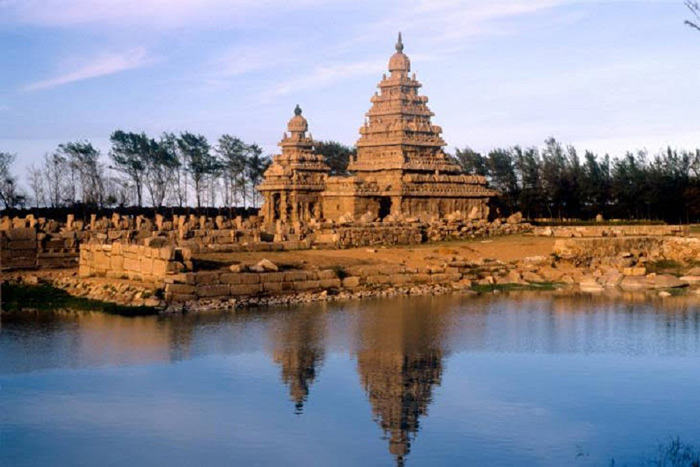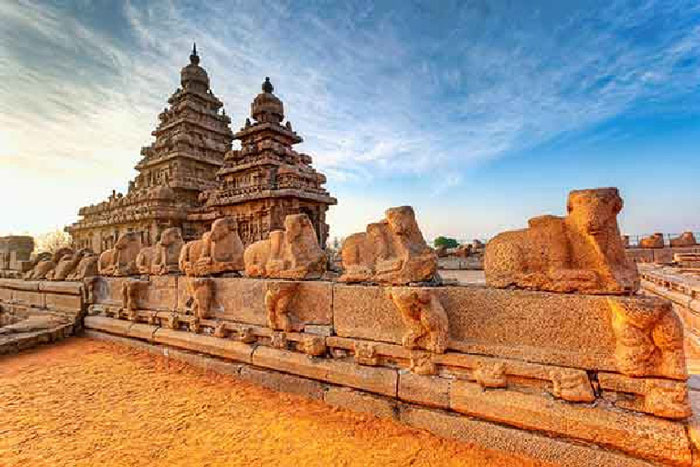Indian Mahabalipuram architectural complex
Unesco's Scientific, Educational and Cultural Organization has recognized India's Mahabalipuram Architectural Complex as a World Cultural Heritage in 1984.
Mahabalipuram architectural complex - World Cultural Heritage in India
The Mahabalipuram architectural complex consists of many different architectural structures built during the Pallava king period from the 7th to the 8th century. The Mahabalipuram architectural complex runs along the Coromandel coast with buildings. it includes: Rathas temple; Madapas cave sanctuary; giant reliefs; Temple of Rivage; There are also thousands of other sculptures.

The Mahabalipuram architectural complex is an important representation and testament to the prosperity of the Pallava dynasty - a dynasty in the southeast of India. Previously, Mahabalipuram was a scenic destination of India, at a flourishing period, the more this port was the trading place between Indian traders and other countries in Southeast Asia such as the Khmer (Cambodia) and the King Shrivijaya (Malaysia) and Champa empires (An Nam). Centuries later, despite the flourishing period, the Mahabalipuram architectural complex remained famous by the Mahabalipuram harbor and the temples of Brahmanism.

The main monuments in the Mahabalipuram architectural complex include:
Rathas Temple : Rathas temple is shaped like a chariot, this is a building built of monolith and connected by sand. Rathas Temple is the most famous in the era of Naharasimhavarman Mamalla (from 630 to 68), at this time Mahabalipuram is a big city of India.
Mandapas Sanctuary (cave conservation area): these are model caves built to contain bas-reliefs of dynasties. These bas-reliefs are mainly about Vishnu, Pandavas and Krisha. Although there are thousands of reliefs, the most valuable reliefs are the reliefs depicting Durga, which depicts the sight of Dugra killing the demon buffalo head Mahishsura. It can be said that this is one of the masterpieces of Indian visual art.


The sculptures on architecture at Mahabalipuram, India
The giant relief is built in the image of the god Shiva , the god of the Ganges and the Indian religion. According to legend, Baghirata king asked the heavens to give the river to people to reduce suffering and drought. King Baghirata's prayer reached the blue sky and Shiva was ordered to create the Ganges to feed the people. This relief was later erected to show gratitude to Lord Shiva.
Rivage's temple is like many other houses in India built from stone. Rivage's temple was built under King Rajasimha Narasimavarmn II (695 -722). The temple has many towers and thousands of sculptures with the main theme being Shiva.

Another architectural beauty that cannot be mentioned is the Shore temple , on the deep blue sea of Shore Temple, standing with a magnificent and magnificent beauty. Shore Temple is also one of the top architectural works of India. Now that this church is being threatened by sea erosion, the sculptures here are increasingly losing focus and becoming unclear.
The Mahabalipuram architectural complex received much attention from the Indian Government after more than 40 years the region was left open. A master planning project of the Mahabalipuram architectural complex was submitted to the Government by the Ministry of Culture and Tourism in 2003. The cleanup and garbage collection work around the heritage area are also regularly carried out. The government has built a fence around the ruins area, resolutely eradicated street vendors, encroachment. Besides, the Government also called on donor organizations to set up lights to illuminate the whole relic area in the evening. Currently, the Indian Government has an ambitious plan to build a road from the back of Shore Temple to circumnavigate the monument to facilitate visitors to visit and develop tourism.







- Detecting the architectural complex of the Tran Dynasty in Nghe An
- Horyu-ji temple's Buddhist architectural complex
- Architectural ensemble at Hampi - India
- Athèna Temple and Acropole architectural complex
- Prambanan temple complex
- The controversial pyramid city off Japan
- Decipher the mysterious red dot on the Indian woman's forehead
- Great architectural inventions of the Romans
- 20 photos won the 2018 architectural photography award: from skyscrapers to ruins
- Divrigi cathedral and hospital (Turkey)
- The most magnificent brick buildings in the world
- Redefining the age of Indian civilization
 Suzhou classic bonsai garden - China
Suzhou classic bonsai garden - China Chau Nguyen Dynasty
Chau Nguyen Dynasty Thai Son Mountain - World Wonder
Thai Son Mountain - World Wonder Ancient villages of Shirakawa-go and Gokayama
Ancient villages of Shirakawa-go and Gokayama